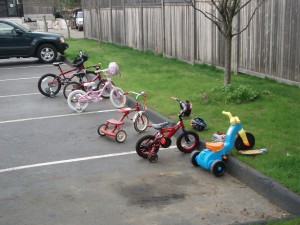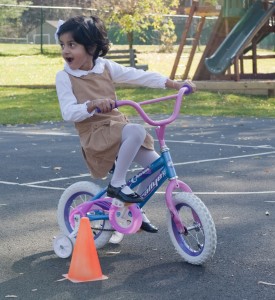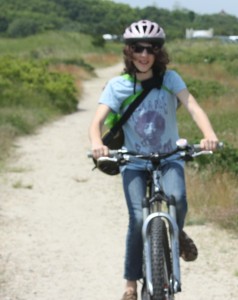I have a sister five years older than me and in my formative years I spent most of my time trying to “catch up” to her. That may be why I learned to ride a two wheeler at three years of age. Having safe sidewalks and uncluttered days to practice at my leisure surely helped a lot! I also think something about the motion was quite organizing for me. I know it is today, 50+ years later, as I still pedal hundreds of miles each summer.
I highlight bicycle riding not because it is a favorite of mine (which it is) but because there are so many great things about it.
Benefits:
- Develops balance.
- Great cardiovascular and body strengthener.
- The speed provides vestibular stimulation.
- Bumpy roads and pumping up hills activate the proprioceptors (brain organizers).
- Falls especially activate proprioceptors and increase body awareness so there is an up side to these little dramas.
- Children learn to operate the bike (pumping) while balancing, while steering, while regulating the speed. This motor integration helps build motor planning ability.
- Since both hands simultaneously hold the handlebars and steer while the legs push and lift up on the pedal, bilateral motor coordination is enhanced.
- Children learn safety rules (which have real consequences if not followed!).
- Older children (who have learned safety rules) have opportunities for some freedom.
- Cycling offers an opportunity for the whole family to go on an extended outing-pack a picnic lunch or head for the local ice cream shop.
The following outlines how children become proficient and safe cyclists while having fun. Scroll to the end of the section for info on cycling trails, opportunities and safety tips.
Preschool
Cruising with Trikes: These teach how to pedal while very stable so no thought of balancing is involved. Some steerage may be learned although the real fun is flying down a slope and crashing (safely) at the end. This helps the child become accustom to increasing speeds. A nice dose of organizing vestibular and proprioceptive input is given as well.
Tricycles begin the real training for future cycling prowess. Steering and pedaling are required to operate the vehicle. Speed control becomes a factor and the need to balance is introduced. If a child tries to cut a quick corner at too fast a speed, the tricycle will topple over.
- Set up little driving courses on the driveway or a playground basketball court (or any equivalent).
- Set up plastic cones (or any miscellaneous objects that mark a turning point) and have the child weave in and out, like a ski slalom run.
- Or make a course such as a big circular race track. These activities help develop steering skills.
- Play “Stop Go” games to teach speed control.
- Training Wheels: Training wheeled bikes are essentially a bridge between a two wheeler and a tricycle. The two outrigger training wheels are slightly higher so the child has the sensation of tipping over before the extra wheel catches and stabilizes the bike. The rider sits higher off the ground so a fall is more serious.*
All the same activities which are listed above should be repeated with training wheels
“Two Wheeler” Bicycle: It is very important that the bike is properly fitted. For the nyophyte rider, begin with a slightly smaller bike so the feet can easily reach the ground to prevent falling.
It is recommended that the first “training” bike be a hand me down or purchased at a tag sale or the like (or check Craig’s list and E-Bay). This is because the child will crash and scratch the bike if true effort is put into learning. This way the child doesn’t have to worry about “wrecking” the beautiful shiny new bike. As a reward for learning, while not necessary, a new bike can be purchased at a later date (such as the next birthday or holiday).
Personally, my favorite bike was a hand me down from my big sister. It was small, so my little three year old legs had no trouble reaching the ground.
Learning to ride a two wheeler varies based on many factors.
- One of the biggest is whether there is a place where the child can practice riding independently. People with parks nearby, or live at the end of a quiet road typically learn sooner. If the only way to practice riding is when Dad or the babysitter hauls the bike into the trunk of the car and a “training session” is scheduled, it makes it more difficult for the child to have the on and off time required to assimilate and integrate the many skills necessary to ride independently.
- Some children learn as early as three years old. Some are still working on this at eight.
- Frequently the three year old wants to keep up with the older siblings, cousins or neighborhood friends (as was the case for me).
Below are strategies to help the neophyte rider acquire the readiness skills to gain confidence and allow the coach to “Let Go.”
- Curb Training: Position the bicycle parallel to the curb. Have the child sit on the saddle with one foot propped up on the curb and the other on the pedal. Gently tip the bike away from the curb so the child has to move the foot off the pedal to stop a fall. Repeat this 500 times (only barely an exageration-you want this to become AUTOMATIC). Turn the bike around so it is facing the opposite direction and repeat this drill (another 500 times).
- Curb Scooting: Once the child is proficient at blocking a fall with the pedal side foot, the child begins to use the curb side foot to propel the bike forward (like a scooter). Over time the child should begin to glide.
Now repeat this whole sequence while holding the bike seat with the child on it. Tip the bike to the right and left so the child has to figure out which foot to use to stop a fall. Then the coach stabilizes the bike as the child pedals. If the child has, indeed, done all that prep work, fear of falling should be diminished and therefore, the child will be ready to have the coach let go sooner.
If the child remains terrified, go back to the curb. If the curb work is too fatiguing or scary, go back to trunk strengthening andbody awareness activities and put the bike away for a while. Pull that trike out again for some fun, carefree cruising.
Whatever the result, make sure to end a “training session” with some fun on the swings, running around, rolling, or whatever is enjoyable for the child in a gross motor kind of way. Learning to ride a bike is demanding and the child needs to “let off some steam” after all that hard work-whether successful or not.
Feeling like a failure, or letting the coach down is NOT an option. It is important to point out one small positive thing that happened during the time spent together, even if it is telling the child how incredibly brave s/he was when falling.
When one learns to ride a bike it is expected that falling will occur. It just happens and it is important to accept this. As an adult (after 40 years of cycling) I bit the bullet and bought clipless cycling shoes and pedals (paradoxically “clipless” means clipped into-or attached to the pedal!). Every experienced cyclist assured me that I would fall. I trained in a huge parking lot for hours (much like my curb drill) to have the release become automatic. In spite of this, going up my last hill after a 60 mile ride, my legs were too tired to push down (I was in the wrong gear-long story) so I toppled over.
As a three year old, I have a hunch that along with wanting to keep up with the big kids, I loved getting those special bandaids. So falling and scraping my knee was a plus. My body also craves lots of proprioceptive input to stay organized so the early bike riding (and falling) took care of that as well.
Guidelines Nascent Riders:
- First rides should be in large open spaces that afford a long cruise in one direction. Typically the child will ride straight until falling down. These long hauls are important because the child will gain a better sense of the center of gravity and the rider will become less wobbly as speed increases.
- Once the child learns to ride steadily, set up slightly larger courses as described for the tricycle and training wheels.
- Learning to steer and balance is a major hurdle to overcome.
- Speed control exercises are also a good thing to practice. With the cone work, this will occur organically. As the child rounds a bend the speed needs to be in check or a fall will occur.
- Learning through these life experiences are quite effective. Which brings us to SAFETY. Once the child mounts a training wheeled bike the helmut needs to go on.
Elementary and Beyond
Assuming the child has learned to ride a bike, opportunities should be found for the child to ride. Family rides and solo rides all balance the childhood experience in a lovely way.
At every period of my life I have found cycling to be an exhilarating and useful outlet.
- I rode for hours, singing at the top of my lungs when I was a young child. I was fortunate because my town had sidewalks everywhere and back then people were not afraid of their kids getting snatched away.
- As a teenager, I no longer lived in a community with sidewalks. But I had learned the rules of the road and found cycling a huge outlet for pent up adolescent angst.
- As a young adult I used my 10 speed Fugi to commute to a major hospital in Boston (until it was stolen from the bike closet where I lived). Later, in Philadelphia, I commuted to work on my bike occasionally. I found riding on city streets exhilarating and useful.
- As I entered my midlife (crisis) I discovered riding helped me reach for bigger physical challenges than I’d ever had. I’ve participated in the PMC (a 190 mile ride spanning 2 days) and ridden over many mountains in Europe. The years keep piling on, but on my bike I can pretend I’m still young!
Since riding has become more difficult due to fewer side walks, more traffic, fewer kid friendly neighborhoods, it is frequently important to find bike trails to provide adequate riding space for the child. Here are a few sources to check out:
- http://www.americantrails.org
- http://www.mapmyride.com
- http://www.trails.com/toptrails.aspx?area=10032
- http://www.pedaling.com
Each state has information regarding the Greenway Project. This is an effort to link up bike trails across the state. Google Greenway Project for your state and you should get information regarding rail trails and the like in your area. The National Park Service also has many wonderful trails so if you are fortunate enough to live near or visit one of these locations, check out the wonderful cycling opportunities for families.
- http://www.nps.gov/findapark/index.htm
- http://www.americanprogress.org/issues/2010/03/ebg031710.html
Family Fund Raising Rides: Introduce your children to philanthropy while enjoying a family ride. Here are some examples of philanthropic organizations that sponsor family or kid rides to raise awareness and funds for specific causes.
There are many more rides. Check with your Local Cycle Shop for information in your area. These shops frequently provide information about best pales to ride as well.
Safety:
It is required by law that children where helmets.
Refer to the be-safe link and you will see some interesting statistics. Childhood accidents and fatalities have been significantly reduced, directly attributable to wearing helmets. Look at the number of fatalities in adults, resulting from lack of helmet use (97%). Think about it. Parents diligently insist that their kids wear a helmet. Then they hop on a bike wearing a baseball cap or nothing. Besides setting a really bad example, it is just plain stupid. Do the math on the force incurred by a 50 pound child falling from a distance (height) of 30 inches, going 8 miles per hour. Now repeat the equation adding 100 or so more pounds, another 10 inches and let’s say 12 miles per hour. There is a huge increase in force (which would be applied to the head).
There are countless tragic stories of adults who suffer head injuries, needlessly. Two grownup members of my family, both experienced cyclist, would have had a serious head injury if they hadn’t been wearing helmets at the time of their falls. Head injuries are not as easy to fix as broken bones. Keep this in mind when you are purchasing the bike and helmet for your little cyclist. Slide over to the adult section. You can find helmets to match your bike or cycling outfit!
- http://kidshealth.org/kid/watch/out/bike_safety.html
- http://www.nhtsa.dot.gov/people/injury/pedbimot/bike/kidsandbikesafetyweb/
- http://www.ibike.org/education/safety-kids.htm
- http://bicyclesafe.com
- http://www.be-safe.org/css_com/bicycle/
Now we can all get out our bikes and go for a ride!



Hi! I have a 23-month-old with some motor planning issues and a gross motor delay. I’d like to get him some kind of bike for his 2nd birthday. Do you have any experience with balance bikes, like a Strider? (link below) The balance bikes are supposed to be great for strengthing core and balance, but I’m not sure if that’s more important/beneficial than learning to pedal. What are your thoughts? Thanks so much! Love this blog!
http://www.striderbikes.com/product/bikes/12/classic/classic
Balance bikes are great but the child needs to have some basic balance skills before hopping on this vehicle. 23 months (great age!) but still really working on basics. Trikes are fabulous to introduce pedal & steering skills with no fear of falling. My kids still screamed down the driveway slope @ 6 & 7 years old on trikes, having a hoot of a time, even though they rode two-wheelers by then. Visit the toddler bike post to see all the benefits and ideas to build those balance skills not yet in place @ two years old. Most important-keep it fun!!!